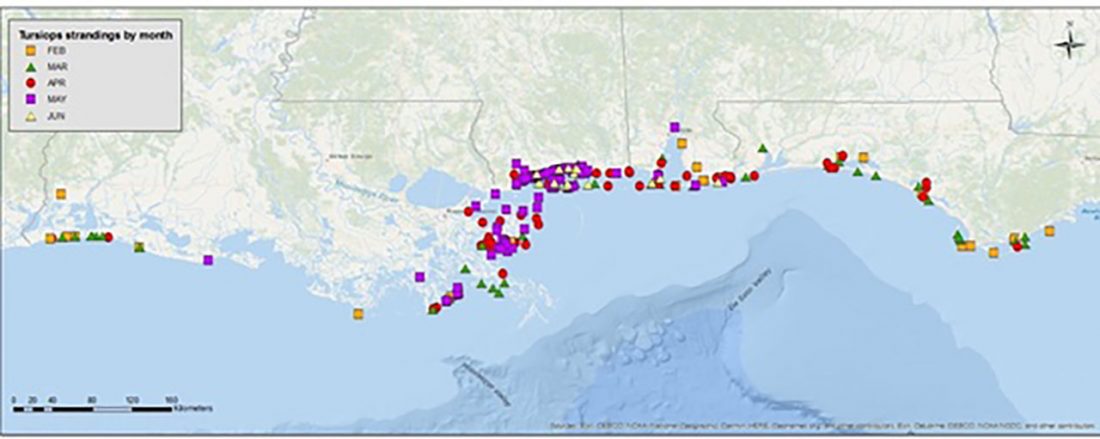261 bottlenose dolphins have washed up dead along the Gulf Coast since February, NOAA announces
Dolphin with suspected freshwater lesions. Photo credit: Institute for Marine Mammal Studies
Elevated bottlenose dolphin strandings have been occurring in the Northern Gulf of Mexico including Louisiana, Mississippi, Alabama, and the panhandle of Florida (Alabama border through Franklin County) since February 1, 2019. To date, more than 261 dolphins have stranded since February 1, 2019 which is approximately three times higher than the average. This event has been declared an Unusual Mortality Event (UME).
Dolphins are Stranding
It is too early to determine any potential causes of the UME. Many of the dolphins recovered are very decomposed, limiting the ability to collect samples to determine cause of illness or death. In addition, a number of dolphins have stranded in remote locations, which limits the Stranding Network’s ability to examine or recover the carcass. Some of the stranded dolphins have had visible skin lesions that are consistent with freshwater exposure. Samples are being collected for testing.
As part of the UME investigation process, an independent team of scientists; an investigative team is being assembled to coordinate with the Working Group on Marine Mammal Unusual Mortality Events to review the data collected and provide guidance for the investigation.
Report a Stranded or Floating Dolphin
Members of the public can assist investigators by immediately reporting any sightings of live dolphins in distress or stranded (floating or on the beach) by calling the 24/7 Southeast Marine Mammal Stranding Network at 877-WHALE HELP (877-942-5343). You can contact the U.S. Coast Guard on VHF Channel 16 or use the Dolphin and Whale 911 app on your smartphone. The stranding network will send out trained responders who will get to the scene quickly with appropriate equipment.
All marine mammals are federally protected by the Marine Mammal Protection Act. Only local and state officials and people authorized by NOAA Fisheries may legally handle live and dead marine mammals.
Do’s and Dont’s
• DON’T push the animal back out to sea! Stranded marine mammals may be sick or injured. Returning animals to sea delays examination and treatment and often results in the animal re-stranding in worse condition.
• If the animal returns to the water on its own, DON’T attempt to interact with it (swim with, ride, etc.).
DO put human safety above animal safety. If conditions are dangerous, do not attempt to approach the animal.
DO stay with the animal until rescuers arrive, but use caution. Marine mammals can be dangerous and/or carry disease. Keep a safe distance from the head and tail. Do not touch the animal and avoid inhaling the animal’s expired air.
• If the animal is alive, DO keep its skin moist and cool by splashing water over its body. Use wet towels to help keep the skin moist and prevent sunburn.
• If the animal is alive, DON’T cover or obstruct the blowhole. Try to keep sand and water away from the blowhole.
• DO keep crowds away and noise levels down to avoid causing further stress to the animal.
• DO report all dead marine mammals, even if they are decomposed.
• DO keep dogs/pets away from the live or dead marine mammal.
• DON’T collect any parts (tissues, teeth, bones, or gear, etc.) from dead animals. They are still covered by the Marine Mammal Protection Act.
2019 bottlenose dolphin stranding locations by month along the Northern Gulf of Mexico UME region. (Louisiana-Florida Panhandle).
Comparison of 2019 monthly bottlenose dolphin strandings (orange) to the 17-year historical monthly average including previous UMEs (blue) and the historical monthly average excluding previous UMEs (green).


